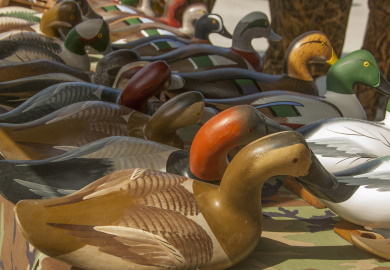August 6, 2019

It will soon be time for South Carolina waterfowl hunters to begin "getting their ducks in a row" for the start of the 2019-2020 seasons. Early teal season begins on September 13, with other seasons to follow throughout the fall and winter.
The seasons and regulations for migratory waterfowl hunting in South Carolina have been approved by the S.C. Department of Natural Resources Board, the policy-making body of the S.C. Department of Natural Resources (SCDNR). Seasons and bag limits for waterfowl and other migratory game birds are approved annually based on a framework set by the U.S. Fish and Wildlife Service (USFWS).
Among the most notable changes for the upcoming 2019-2020 season, is the reduction in the daily bag limit for mallards from 4 to 2 birds (only one (1) of which can be a hen). The reduction is a carefully considered response to a long-term decline in the population of Northeast mallards (those that breed and winter in the Atlantic Flyway), says SCDNR Biologist Molly Kneece, a waterfowl manager who represents the Department on the Atlantic Flyway Council Technical Section. Mallard populations in other flyways are in good shape.
In other changes, the daily bag limit for Northern pintails has also been reduced this season to 1 bird. The bag limit for black ducks remains at 2, but only 1 black or mottled duck per day may be harvested in areas east of Interstate 95. All waterfowl hunters should also take note that there is no open season for tundra swans in South Carolina.
As far as the outlook for the 2019-2020 season goes, at least one indicator is pointing in the right direction.
"The Atlantic Flyway Breeding Waterfowl Plot Survey showed average to good nesting effort for ducks this year," said Kneece. "But to quote my predecessor [long-time SCDNR Waterfowl Project Coordinator Dean Harrigal]. 'To have ducks you need three things—food, water, and weather.' "
SCDNR biologists and technicians are working hard on the first part of that equation. Managed wetlands on the Palmetto State's Category I and Category II Waterfowl Areas, as well as our abundant lakes, rivers and tens-of-thousands of privately-owned and managed waterfowl habitat supply the second.
"We are producing abundant food on our waterfowl WMAs across the state," said Kneece. "Our biologists and managers continue work toward setting the table for migratory waterfowl this winter and are hopeful for some forgiving fall weather. The number of migrating waterfowl that show up in South Carolina during the winter largely depends on winter weather conditions; cold, snow, or extremely dry conditions to the north and west can mean good numbers of waterfowl in our state. We're hopeful to see the right combination of fall and winter weather to push waterfowl to South Carolina during the 2019-2020 season."
Updated information and details about the 2019-202 waterfowl seasons is available now on the SCDNR website, and paper copies of the 2019-2020 version of "South Carolina Hunting & Fishing; The Official State Regulation Guide" (aka the "Rules & Regs" Booklet) will be distributed to retail stores that sell hunting and fishing licenses over the coming weeks. Electronic versions of the updated Regulation Guides are available now on the SCDNR website in both PDF and mobile device-friendly formats.



